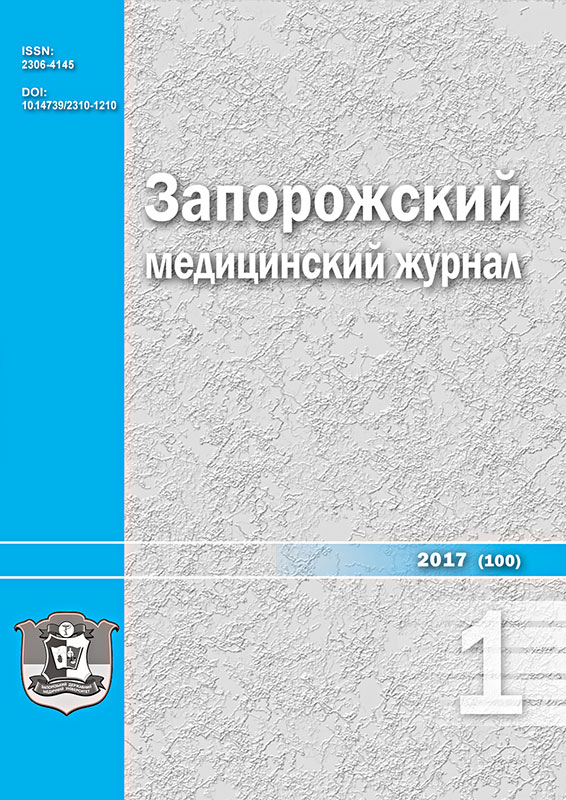The condition of the processes of lipid peroxidation and antioxidant defense of the blood in parturient women with rheumatism
DOI:
https://doi.org/10.14739/2310-1210.2017.1.91712Keywords:
pregnancy, rheumatic process, lipid peroxidation, antioxidant system of the blood defenseAbstract
Aim. To study the condition of the processes of lipid peroxidation and antioxidant defense of the blood in parturient women with the rheumatic heart diseases depending on the activity of the rheumatic process and the stage of the blood circulation deficiency.
Material and methods. The level of lipid hydroperoxides, malonaldehyde, glutathione and glutathione-peroxidase before delivery and in the delivery dynamics in patients with rheumatism and healthy women were studied.
Results. More significant intensification of lipid peroxidation has been shown in parturient women with active stage of the rheumatic process than in patients with inactive phase. Thus, the content of lipid hydroperoxides in term II of delivery constituted 1.7±0.2 mcmol/ml erythrocytes and 1.55±0.6 mcmol/ml erythrocytes accordingly. The level of malonaldehyde was 146.8±3.4 mcmol/ml erythrocytes and 135.8±3.5 mcmol/ml erythrocytes accordingly. Herein, the level of the restored glutathione in women with the active phase of the rheumatic process didn’t increase that is evidence of antioxidant insufficiency. The most significant disturbances were observed in parturient women with active phase of the rheumatic process in stage II of the blood circulation deficiency. Glutathione level decrease (24.5± 0.9 mcmol/ml erythrocytes) was observed in these women in term III of delivery in response to intensification of the lipid peroxidation processes in comparison with the parturient women with the stage I of the blood circulation deficiency (36.7±1.3 mcmol/ml erythrocytes, as well as glutathione-peroxidase activity decrease (27.6±1.2 mcmol/ml erythrocytes and 33.9±1.3mcmol/ml erythrocytes accordingly). It is indicative of exhaustion of antioxidant system defense.
Conclusions. Pathological increase of lipid peroxidation products in the blood of parturient women with rheumatism in the presence of antioxidant deficiency is evidence of the derangement of the organism adaptation processes to stress situations at delivery.
References
Bakhareva, I. V. (2014). Rol' antioksidantov pri beremennosti vysokogo riska [The role of antioxidants in high risk pregnancy]. Ginekologiya, 1, 90–96. [in Russian].
Kolesnikova, L. I, Darenskaya, M. A., Grebenkina, L. A., Dolgikh, M. I., & Osipova, E. V. (2012). Sistema «POL-antioksidanty» u beremennykh vysokogo perinatal'nogo riska dvukh e´tnicheskikh grupp [The system «LPO-antioxidants» in pregnant women of high perinatal risk in two ethnic groups]. Sibirskij medicinskij zhurnal, 115(8), 011–013. [in Russian].
Korovay, S. V. (2012). Nekotoryye pokazateli svobodnoradikal'nogo okisleniya i lipidnogo obmena u beremennykh s prezhdevremennymi rodami i e´ndotelial'noj disfunkciej [Some indexes of the free-radical oxidation and lipid exchange that have pregnants with the premature birth and endothelial dysfunction]. Ukrainskyi zhurnal klinichnoi ta laboratornoi medytsyny, 7(4), 32–36. [in Ukrainian].
Prokopenko, V. M., & Pavlova, M. G. (2014). Znachenie glutation-zavisimykh fermentov antioksidantnoj zashchity v funktsional'noj aktivnosti placenty cheloveka [Significance of glutathione – dependent enzymes of antioxidant defense in functional activity of the human being placenta]. Akusherstvo i ginekologiya, 11, 62–67. [in Russian].
Repina, M. A., & Kuzmina-Krutetskaya, S. R. (2008). Priobretennye poroki serdca i beremennost' (v pomoshch' prakticheskomu vrachu) [Acquired valvular heart diseases and pregnancy]. Zhurnal akusherstva i zhenskikh boleznej, 1, 100–108. [in Russian].
Shalina, R. I., & Kanzapetov, M. R. (2013). Antioksidanty i ikh rol' v akusherskoj praktike [Antioxidants and their role in obstetrics practice]. Ginekologiya, 15(5), 3–7. [in Russian].
Beutler, E., Duron, O., & Kelly, B. (1963). The definition of glutathione in blood. Zh. Lab. Klin. Med., 61(5), 882–886.
Knuppel, R. A., Hassan, M. I., Mc Dermott, J. J. et al. (2012) Oxidative stress and antioxidants: preterm birth and preterm infants, preterm birth – mother and child. J. Morrison. Retreved from: http://www.intechopen.com.
Mert, I., Oruc, A. S., Yuksel, S., Cakar, E. S., Buyukkagnici, U., Karaer, A., & Danisman, N. (2012) Role of oxidative stress in preeclampsia and intrauterine growth restriction. J Obstet Gynaecol Res, 38(4), 658–64. doi: 10.1111/j.1447-0756.2011.01771.x.
Olinescu R., Nita S. (1973). Influence of hemoproteins on glutathione peroxidase activity. Rev. Rum. Biokhi, 10(2), 119–125.
Downloads
How to Cite
Issue
Section
License
Authors who publish with this journal agree to the following terms:
Authors retain copyright and grant the journal right of first publication with the work simultaneously licensed under a Creative Commons Attribution License that allows others to share the work with an acknowledgement of the work's authorship and initial publication in this journal. 
Authors are able to enter into separate, additional contractual arrangements for the non-exclusive distribution of the journal's published version of the work (e.g., post it to an institutional repository or publish it in a book), with an acknowledgement of its initial publication in this journal.
Authors are permitted and encouraged to post their work online (e.g., in institutional repositories or on their website) prior to and during the submission process, as it can lead to productive exchanges, as well as earlier and greater citation of published work (See The Effect of Open Access)

